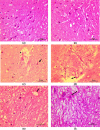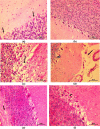Neuroprotective effect of quercetin and Zingiber officinale on sodium arsenate-induced neurotoxicity in rats
- PMID: 37324922
- PMCID: PMC10261772
- DOI: 10.1002/fsn3.3278
Neuroprotective effect of quercetin and Zingiber officinale on sodium arsenate-induced neurotoxicity in rats
Abstract
The study was aimed at determining the ameliorative potential of quercetin and Zingiber officinale (ZO) against sodium arsenate-induced neurotoxicity in male Wistar rats. Thirty adult animals were randomly allocated to five groups (n = 6). Group I served as control, groups II and IV were treated with ZO [300 mg/kg, PO (per os)/day], and group V animals were administered quercetin (50 mg/kg, PO/day) for 18 days. Groups III, IV, and V were injected with sodium arsenate (20 mg/kg, intraperitoneally/day) for 4 days starting from day 15. The administration of sodium arsenate resulted in a significant decrease in total antioxidant status, total thiols, superoxide dismutase, catalase, glutathione peroxidase, glutathione reductase, and aryl esterase in brain tissue of the animals compared with the control group. In addition, a significant increase was observed in malondialdehyde, advanced oxidation protein product and plasma nitric oxide levels, indicating oxidative stress-mediated neuronal damage. However, these arsenic-induced alterations were significantly reversed by quercetin or ZO in the treatment groups, indicating their ameliorative potential. These positive effects were further confirmed by histopathological examination of brain tissue revealing the suppression of severe neuronal injury, spongiosis and gliosis in the samples pretreated with quercetin and ZO. Our results suggest that inclusion of ZO and quercetin-rich foods in the diet can help in preventing the neurotoxic effects in areas with elevated levels of arsenic in food chain and ground water.
Keywords: Wistar rats; Zingiber officinale; antioxidant status; arsenic; neurotoxicity; quercetin.
© 2023 The Authors. Food Science & Nutrition published by Wiley Periodicals LLC.
Conflict of interest statement
The authors declare that there is no conflict of interest.
Figures



Similar articles
-
Zingiber officinale and 6-gingerol alleviate liver and kidney dysfunctions and oxidative stress induced by mercuric chloride in male rats: A protective approach.Biomed Pharmacother. 2017 Jul;91:645-655. doi: 10.1016/j.biopha.2017.04.108. Epub 2017 May 8. Biomed Pharmacother. 2017. PMID: 28494418
-
Neuroprotective role of 6-Gingerol-rich fraction of Zingiber officinale (Ginger) against acrylonitrile-induced neurotoxicity in male Wistar rats.J Basic Clin Physiol Pharmacol. 2018 Dec 22;30(3). doi: 10.1515/jbcpp-2018-0114. J Basic Clin Physiol Pharmacol. 2018. PMID: 30864424
-
Mercury chloride causes cognitive impairment, oxidative stress and neuroinflammation in male Wistar rats: The potential protective effect of 6-gingerol-rich fraction of Zingiber officinale via regulation of antioxidant defence system and reversal of pro-inflammatory markers increase.Brain Res. 2024 Mar 1;1826:148741. doi: 10.1016/j.brainres.2023.148741. Epub 2023 Dec 27. Brain Res. 2024. PMID: 38157955
-
Neuroprotective effects of protocatechuic acid on sodium arsenate induced toxicity in mice: Role of oxidative stress, inflammation, and apoptosis.Chem Biol Interact. 2021 Mar 1;337:109392. doi: 10.1016/j.cbi.2021.109392. Epub 2021 Jan 23. Chem Biol Interact. 2021. PMID: 33497687
-
Zingiber officinale Ethanolic Extract Attenuated Reserpine-Induced Depression-Like Condition and Associated Hippocampal Aberrations in Experimental Wistar Rats.J Exp Pharmacol. 2020 Nov 2;12:439-446. doi: 10.2147/JEP.S275260. eCollection 2020. J Exp Pharmacol. 2020. PMID: 33173355 Free PMC article.
Cited by
-
Tiryāq in traditional Persian medicine: a survey of antidotal plants and their modern pharmacological potential.Front Pharmacol. 2025 Apr 2;16:1503149. doi: 10.3389/fphar.2025.1503149. eCollection 2025. Front Pharmacol. 2025. PMID: 40242443 Free PMC article. Review.
-
The neurotoxic effects of lead acetate and the abrogating actions of 6-gingerol-rich extract of ginger via modulation of antioxidant defence system, pro-inflammatory markers, and apoptotic cascade.Naunyn Schmiedebergs Arch Pharmacol. 2025 Jul;398(7):9341-9356. doi: 10.1007/s00210-025-03873-x. Epub 2025 Feb 12. Naunyn Schmiedebergs Arch Pharmacol. 2025. PMID: 39937255
-
Nano-mediated Management of Metal Toxicity-induced Neurodegeneration: A Critical Review.Mol Neurobiol. 2025 Jul;62(7):8400-8419. doi: 10.1007/s12035-025-04782-z. Epub 2025 Feb 25. Mol Neurobiol. 2025. PMID: 39994160 Review.
References
-
- Aebi, H. (1974). Catalase. In Bergmeyer H. U. (Ed.), Methods of enzymatic analysis (pp. 673–684). Verlag Chemie/Academic Press Inc. 10.1016/b978-0-12-091302-2.50032-3 - DOI
-
- Alam, M. N. , Hossain, M. M. , Rahman, M. M. , Subhan, N. , Mamun, M. A. A. , Ulla, A. , Reza, H. M. , & Alam, M. A. (2018). Astaxanthin prevented oxidative stress in heart and kidneys of isoproterenol‐administered aged rats. Journal of Dietary Supplements, 15, 42–54. - PubMed
-
- Bahrami, A. , Sathyapalan, T. , Moallem, S. A. , & Sahebkar, A. (2020). Counteracting arsenic toxicity: Curcumin to the rescue? Journal of Hazardous Materials, 400, 123160. - PubMed
-
- Burlina, A. , Michielin, E. , & Galzigna, L. (1977). Characteristics and behaviour of arylesterase in human serum and liver. European Journal of Clinical Investigation, 7, 17–20. - PubMed
LinkOut - more resources
Full Text Sources

